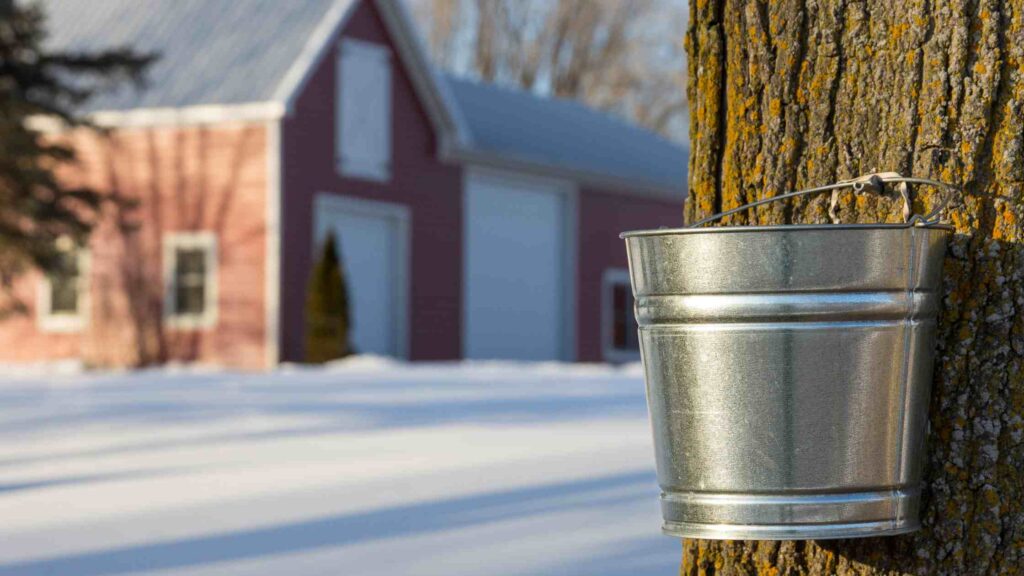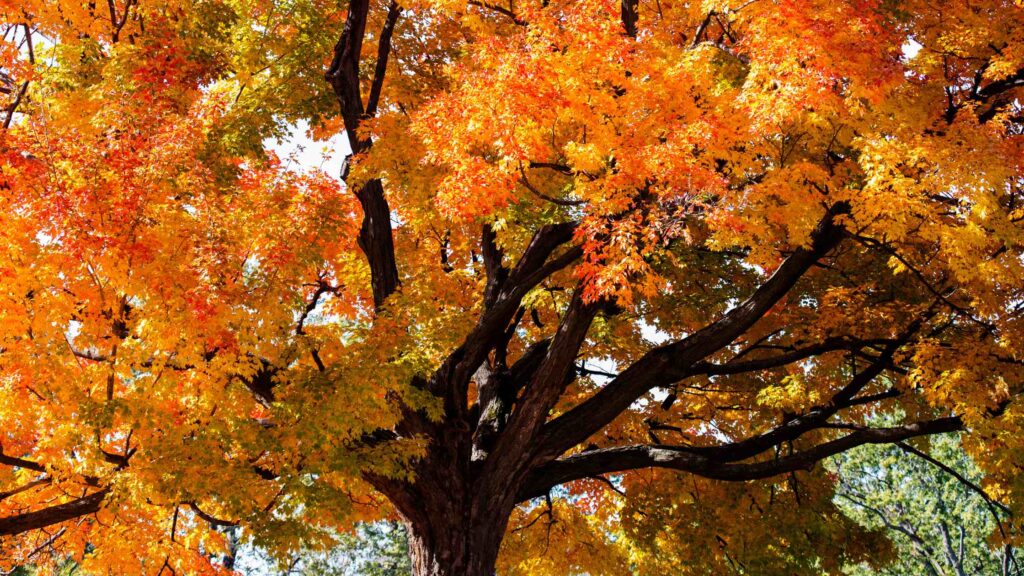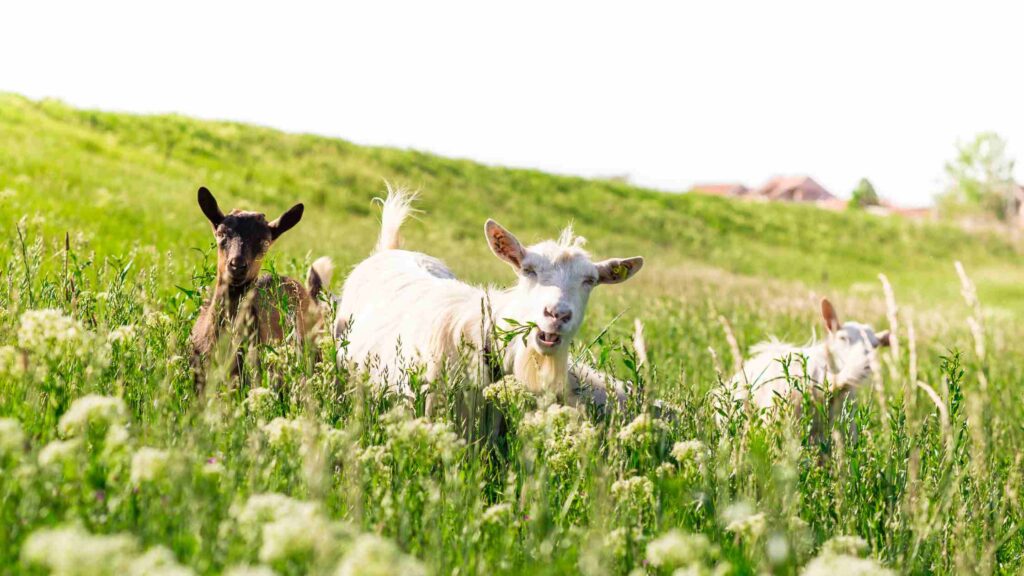I recently discovered that a variety of trees can be tapped for syrup! This was an exciting discovery for me, as I realized we had a few of these varieties on our 20 acres, and I would be putting this to the test.
First, let’s discover HOW to tap trees, as that’s important and probably more simple than you anticipated. The biggest factor to consider is timing.
Tapping trees for syrup is a time-honored tradition that requires careful preparation and technique. Whether you’re harvesting sap from maple, birch, or other species, the process follows similar principles. Here’s a detailed tutorial on how to tap syrup from trees:

1. Choose the Right Tree Species:
Before tapping, identify suitable tree species known for their sap-producing capabilities. While sugar maple is the most commonly tapped tree, other options include red maple, birch, walnut, and hickory. Ensure the tree is healthy, mature (at least 10-12 inches in diameter), and located in a suitable environment for sap flow.
Below is the detailed list of trees you can tap.
2. Gather Equipment and Supplies:
Gather the necessary equipment and supplies for tapping, including:
- Drill with a suitable bit size (5/16 to 7/16 inches for most taps)
- Tapping spiles or spouts
- Collection containers (buckets or bags)
- Hammer or mallet
- Clean storage containers for sap
- Filtering materials (cheesecloth or coffee filters)
3. Plan Your Tapping Schedule:
Timing is crucial for successful tapping. Aim to tap trees when daytime temperatures consistently hover above freezing while nights remain below freezing. This fluctuation creates the pressure differential necessary for sap flow. In most regions, tapping occurs in late winter to early spring, typically February to March.
4. Identify Tapping Sites:
Choose suitable tapping sites on the tree’s south-facing side, where sunlight exposure promotes sap flow. Select healthy, sound areas of the trunk, avoiding damaged or diseased sections. Space taps at least a few inches apart and avoid tapping directly above or below previous tap holes.
5. Drill Tap Holes:
Using a drill with the appropriate bit size, carefully drill tap holes into the tree at a slight upward angle. The hole depth should be approximately 1.5 to 2 inches, deep enough to penetrate the sapwood layer without reaching the heartwood. Wipe away any debris from the hole.
6. Insert Tapping Spiles:
Gently tap the spiles or spouts into the pre-drilled holes using a hammer or mallet. Ensure a snug fit to prevent leaks and secure the spiles in place. Attach collection containers (buckets or bags) to the spouts, ensuring a tight seal to prevent contamination.
7. Monitor Sap Flow:
Check the collection containers regularly to monitor sap flow. Depending on weather conditions and tree species, sap may flow slowly or rapidly. Expect to collect approximately 10-20 gallons of sap per tap hole over the tapping season, though yields can vary significantly.
8. Collect and Store Sap:
Once collected, promptly transfer the sap to clean storage containers to prevent spoilage. Store sap in a cool environment or refrigerate it if immediate processing is not possible. Avoid letting sap sit for prolonged periods, as it can ferment or develop off-flavors.
9. Process Sap into Syrup:
To transform sap into syrup, boil it down to concentrate the sugars and remove excess water. Use a large, flat-bottomed pan or an evaporator specifically designed for syrup production. Boil the sap over a consistent heat source, such as a wood-fired stove or propane burner, until it reaches the desired consistency and sweetness (approximately 66-67% sugar content).
10. Filter and Bottle Syrup:
Once the sap has reached syrup consistency, remove it from the heat and allow it to cool slightly. Filter the syrup through cheesecloth or coffee filters to remove any impurities or sediment. Bottle the filtered syrup in clean, sterilized containers, and store it in a cool, dark place.
11. Clean and Maintain Equipment:
After tapping season concludes, remove the spiles and clean them thoroughly with hot, soapy water. Store tapping equipment in a dry, well-ventilated area to prevent mold or corrosion. Proper maintenance ensures equipment longevity and prepares you for the next tapping season.

Top 16 Tree Varieties for Ideal Syrup
From the verdant forests of maple-rich regions to the diverse landscapes of birch and beyond, trees offer a deliciously sweet gift: syrup. While maple syrup may be the most well-known, numerous tree species around the world produce sap that can be tapped and boiled down into delectable syrups. Let’s delve into the fascinating world of tree tapping, exploring 20 varieties of trees that yield syrup, each with its unique flavor profile and tapping process.
- Sugar Maple (Acer saccharum):
- Renowned as the king of syrup trees, sugar maple produces the classic maple syrup enjoyed worldwide.
- Tapping occurs in late winter to early spring when temperatures fluctuate between freezing at night and above freezing during the day.
- Red Maple (Acer rubrum):
- While its sap has a lower sugar content than sugar maple, red maple syrup boasts a unique flavor profile with hints of vanilla and caramel.
- Tapping season typically coincides with sugar maple, though the sap may flow earlier in some regions.
- Black Maple (Acer nigrum):
- Similar to sugar maple but with a slightly higher sugar content, black maple produces a rich, amber-colored syrup prized for its robust flavor.
- Tapping methods and timing align closely with those of sugar maple.
- Silver Maple (Acer saccharinum):
- Despite its lower sugar content, silver maple sap can still be tapped for syrup, though it requires more boiling to reach the desired consistency.
- Tapping typically occurs earlier in the season, as silver maple sap flows before sugar maple in many regions.
- Norway Maple (Acer platanoides):
- Introduced to North America from Europe, Norway maple produces sap that can be tapped for syrup, though its flavor is less desirable than native maple species.
- Tapping practices mirror those of other maples, though sap flow may be less predictable.
- Box Elder (Acer negundo):
- Also known as Manitoba maple or ash-leaved maple, box elder produces sap that can be tapped for syrup, though its flavor is less sweet and more watery than traditional maples.
- Tapping occurs in late winter, similar to other maple species.
- Birch (Betula spp.):
- Several species of birch trees, including black birch (Betula lenta) and yellow birch (Betula alleghaniensis), produce sap that can be tapped for syrup.
- Tapping typically begins in late winter to early spring, before the trees leaf out.
- Walnut (Juglans spp.):
- Black walnut (Juglans nigra) and butternut (Juglans cinerea) trees produce sap that can be tapped for syrup, though it requires more boiling to concentrate the sugars.
- Tapping occurs in late winter to early spring, similar to other hardwood trees.
- Hickory (Carya spp.):
- Several species of hickory trees, including shagbark hickory (Carya ovata) and pignut hickory (Carya glabra), produce sap that can be tapped for syrup.
- Tapping typically begins in late winter, before the trees leaf out and sap flow ceases.
- Beech (Fagus spp.):
- American beech (Fagus grandifolia) trees produce sap that can be tapped for syrup, though its sugar content is lower than that of maples.
- Tapping occurs in late winter to early spring, similar to other hardwood trees.
- Sycamore (Platanus spp.):
- Sycamore trees, including American sycamore (Platanus occidentalis) and London plane (Platanus × acerifolia), produce sap that can be tapped for syrup, though it has a lower sugar content than maples.
- Tapping typically begins in late winter to early spring, similar to other hardwood trees.
- Basswood (Tilia spp.):
- American basswood (Tilia americana) produces sap that can be tapped for syrup, though its sugar content is lower than that of maples.
- Tapping occurs in late winter to early spring, similar to other hardwood trees.
- Bigleaf Maple (Acer macrophyllum):
- Found in the Pacific Northwest, bigleaf maple produces sap that can be tapped for syrup, though it has a lower sugar content than eastern maples.
- Tapping methods and timing vary depending on regional climate and sap flow.
- Ironwood (Ostrya spp.):
- Ironwood trees, including hop hornbeam (Ostrya virginiana), produce sap that can be tapped for syrup, though its sugar content is lower than that of maples.
- Tapping typically occurs in late winter to early spring, similar to other hardwood trees.
- Bitternut Hickory (Carya cordiformis):
- Bitternut hickory produces sap that can be tapped for syrup, though it has a more bitter flavor compared to other hickory species.
- Tapping methods and timing align closely with those of other hardwood trees.
- American Elm (Ulmus americana):
- While American elm trees were historically tapped for syrup, their population decline due to Dutch elm disease and has a lower sap sugar content compared to maple trees. However, with proper technique, it’s possible to extract sap from American elm trees and transform it into a flavorful syrup.

